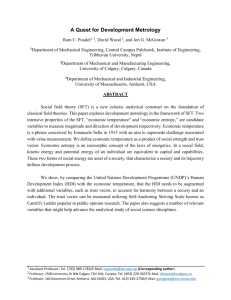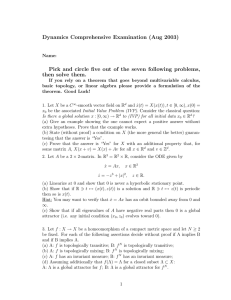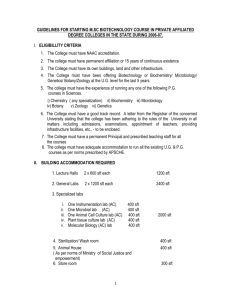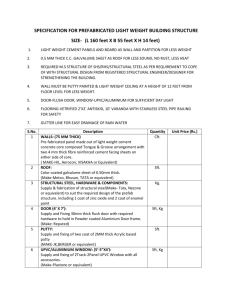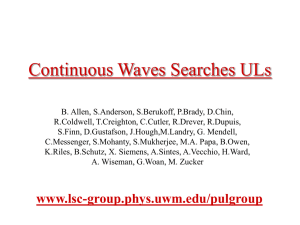Atomic-scale dynamic process of deformation-induced stacking fault tetrahedra in gold nanocrystals ARTICLE
advertisement
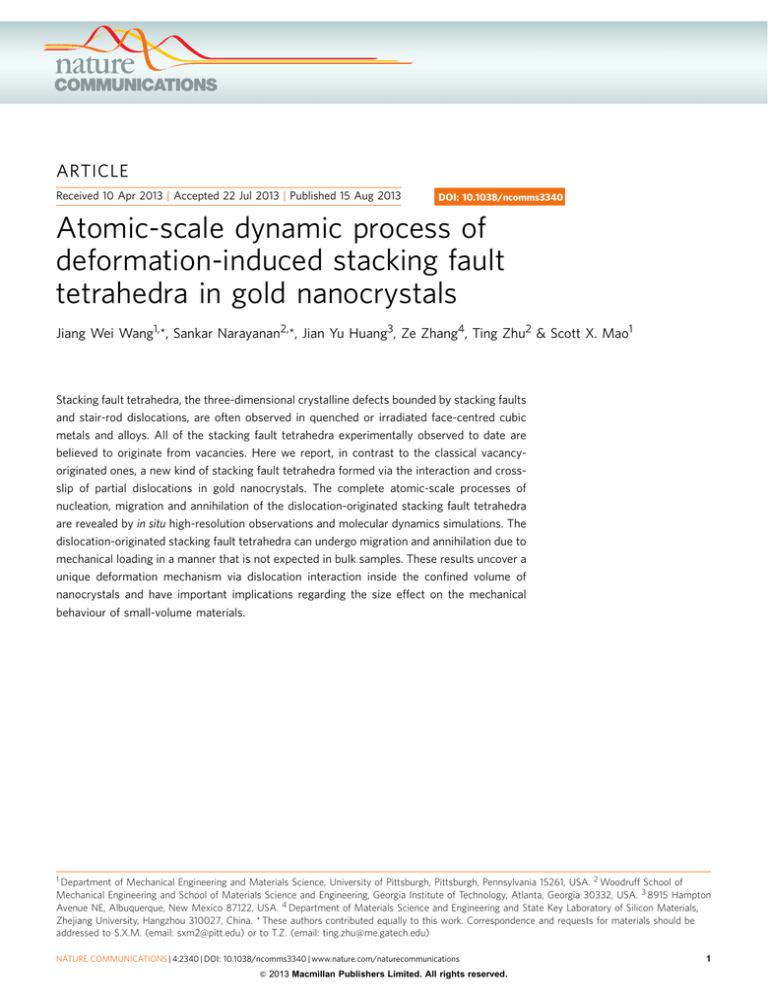
ARTICLE
Received 10 Apr 2013 | Accepted 22 Jul 2013 | Published 15 Aug 2013
DOI: 10.1038/ncomms3340
Atomic-scale dynamic process of
deformation-induced stacking fault
tetrahedra in gold nanocrystals
Jiang Wei Wang1,*, Sankar Narayanan2,*, Jian Yu Huang3, Ze Zhang4, Ting Zhu2 & Scott X. Mao1
Stacking fault tetrahedra, the three-dimensional crystalline defects bounded by stacking faults
and stair-rod dislocations, are often observed in quenched or irradiated face-centred cubic
metals and alloys. All of the stacking fault tetrahedra experimentally observed to date are
believed to originate from vacancies. Here we report, in contrast to the classical vacancyoriginated ones, a new kind of stacking fault tetrahedra formed via the interaction and crossslip of partial dislocations in gold nanocrystals. The complete atomic-scale processes of
nucleation, migration and annihilation of the dislocation-originated stacking fault tetrahedra
are revealed by in situ high-resolution observations and molecular dynamics simulations. The
dislocation-originated stacking fault tetrahedra can undergo migration and annihilation due to
mechanical loading in a manner that is not expected in bulk samples. These results uncover a
unique deformation mechanism via dislocation interaction inside the confined volume of
nanocrystals and have important implications regarding the size effect on the mechanical
behaviour of small-volume materials.
1 Department of Mechanical Engineering and Materials Science, University of Pittsburgh, Pittsburgh, Pennsylvania 15261, USA. 2 Woodruff School of
Mechanical Engineering and School of Materials Science and Engineering, Georgia Institute of Technology, Atlanta, Georgia 30332, USA. 3 8915 Hampton
Avenue NE, Albuquerque, New Mexico 87122, USA. 4 Department of Materials Science and Engineering and State Key Laboratory of Silicon Materials,
Zhejiang University, Hangzhou 310027, China. * These authors contributed equally to this work. Correspondence and requests for materials should be
addressed to S.X.M. (email: sxm2@pitt.edu) or to T.Z. (email: ting.zhu@me.gatech.edu)
NATURE COMMUNICATIONS | 4:2340 | DOI: 10.1038/ncomms3340 | www.nature.com/naturecommunications
& 2013 Macmillan Publishers Limited. All rights reserved.
1
ARTICLE
NATURE COMMUNICATIONS | DOI: 10.1038/ncomms3340
P
lastic deformation in metals and alloys is governed by the
generation and evolution of defects of point, line, plane and
volume types1,2. Among these defects, stacking fault
tetrahedra (SFT), bounded by stacking faults (SFs) and stair-rod
dislocations, are peculiar types of volume defect typically found in
face-centred cubic (FCC) crystals with low stacking fault
energy1,3. Generally, SFT can be introduced by three methods,
that is, quenching, high-energy particle irradiation and plastic
deformation3–8. In 1959, Silcox and Hirsch4 first observed SFT in
quenched gold (Au). They proposed that SFT were formed from
the Frank dislocation loops generated by collapsed vacancy
clusters, which further dissociated through the Silcox–Hirsch
mechanism1,4 to produce the three-dimensional (3D) SFT. Since
then, extensive studies have been conducted on the vacancyoriginated SFT in quenched, irradiated or plastically deformed
bulk FCC crystals3–24. However, whether the SFT can be possibly
initiated by dislocations without the aid of vacancies remain
largely unexplored. If possible, how do SFT form, migrate and
annihilate, particularly at the nanoscale level?
It is well known that the smaller tends to be stronger25,26 and
the free surface in nano-sized crystals acts as an effective source of
dislocations27–29. However, surface nucleation only leads to a
weak size effect on the strength of nanocrystals27,30, for example,
the predicted logarithmic scaling of strength versus nanopillar/
nanowire diameter as opposed to the measured power law scaling.
Hence, the widely observed size effect is generally believed to arise
from dislocation interactions inside nanocrystals. Moreover, the
study of plasticity in nanocrystals has until now been focused on
one-dimensional (1D) (dislocation) and two-dimensional (2D)
(grain boundary) defects27–29,31–33. It remains unclear whether
higher-order defects, such as the 3D volume defect of SFT, can be
generated inside the confined volume of nanocrystals by pure
mechanical deformation. Furthermore, as the sources of partial
dislocation are abundant at the surface27–29, they might facilitate
the interactions between partials and SFT in the small volume of
nanocrystals. It is thus expected that the dynamic evolution of the
SFT might be uniquely mediated by SFs in the nanoscale regime.
0s
However, because of technical difficulties in controlling the
samples at the nanoscale level, it has been a challenge to directly
explore the dislocation interaction, as well as the formation and
evolution of higher order defects, in small-volume nanocrystals.
Here we report the first direct visualization of the formation
and evolution of the deformation-induced SFT via dislocation
interactions during in situ tensile testing of Au nanocrystals with
high-resolution transmission electron microscopy (HRTEM).
Aided by large-scale molecular dynamics (MD) simulations, we
show that the SFT can be produced in nanocrystals directly
through dislocation interactions. The presence of vacancies that is
critical for the initiation of SFT in the bulk is no longer a prerequisite for the SFT formation in the nanoscale. We hence term
the SFT formed in the nanocrystals as ‘dislocation-originated’
SFT, specifically because of its origin being solely controlled by
dislocation interaction events. Our finding, to our knowledge, is
the first ever instance of SFT formation reported in the nanoscale
regime. Moreover, we observe the migration and annihilation of
the dislocation-originated SFT, which are proved to be a direct
outcome of dislocation–SFT interactions.
Results
Formation of Dislocation-originated SFT by Dislocation
Interactions. Figure 1 and Supplementary Movie 1 show the
formation of a dislocation-originated SFT through the interactions of partial dislocations in an Au nanowire. The Au nanowire
is 16 nm in diameter and contains a growth twin boundary (TB).
It is loaded along the [111] direction and viewed along the ½110
direction (Fig. 1a). During tensile deformation, the partial dislocation typically nucleates from the free surface and moves into
the Au nanowire (Fig. 1b), which is consistent with our previous
experimental observations28,29. It is observed that several SFs
nucleate sequentially at different sites of the free surface. They
glide on the equivalent, inclined {111} planes (denoted as SF1, SF2
and SF3, respectively) and interact with each other inside the Au
nanowire, forming a wedge and then a zigzag dislocation
202 s
33 s
SF1
TB
-- )
(111
(111)
-[112]
[110]
SF2
[112]
[111]
221 s
433 s
380 s
SFT
SF3
Figure 1 | Formation of dislocation-originated SFT. (a) Crystallographic orientation of the Au nanowire embedded with a TB. The nanowire diameter is
about 16 nm. (b–f) Sequential HRTEM images showing the evolution of dislocation structure and the formation of a dislocation-originated SFT via the
interactions of partial dislocations under [111] tensile loading. Upon tensile loading, the partial dislocations with SFs nucleate sequentially from the free
surface on the equivalent inclined {111} planes and interact with each other, forming a wedge (c) and then a zigzag (d) dislocation structure. (e) At 380 s,
SF3 propagates and annihilates at the free surface, leaving behind the wedge structure. The inset shows the enlarged HRTEM image of the wedge
structure (yellow dashed line). (f) The wedge dislocation structure further evolves into a triangular defect, which is identified to be an SFT. The inset marks
out the SFT by a yellow triangle. Scale bar, 5 nm.
2
NATURE COMMUNICATIONS | 4:2340 | DOI: 10.1038/ncomms3340 | www.nature.com/naturecommunications
& 2013 Macmillan Publishers Limited. All rights reserved.
ARTICLE
NATURE COMMUNICATIONS | DOI: 10.1038/ncomms3340
structure (Fig. 1c,d). Such interactions between the SFs are the
first step of the formation of dislocation-originated SFT. As the
tensile load increases, SF3 starts to move and eventually annihilates at the free surface, leaving behind a wedge structure between
SF1 and SF2 (Fig. 1e). This wedge structure involves both SF1 and
SF2 with a 1/6o1104-type stair-rod dislocation at the intersection between the two SFs (inset in Fig. 1e). It further evolves
under the applied load, resulting in a 2–3-nm-sized triangular
defect (as indicated by the yellow triangle in the inset of Fig. 1f).
Such a triangular defect is identical to the projected view of SFT
along the ½110 direction in both its shape and geometric angles
(Supplementary Fig. S1a,b). Moreover, the morphology of this
triangular defect appears to be the same as that of the vacancyoriginated SFT reported in the literature6,12,34.
Figure 2 shows the formation of dislocation-originated SFT via
dislocation interactions in an Au nanowire, as realized in our MD
simulations. The Au nanowire is subjected to tensile loading
along the [111] axial direction. Similar to our experimental
observation, a leading partial dislocation of 1/6o1124-type and
of a Schmid factor of 0.31 (denoted as bA in Fig. 2f) is seen to
nucleate from the nanowire surface; it propagates on the ð111Þ
plane, leaving SF1 behind (Fig. 2a). Subsequently, two new partial
dislocations, denoted as dA and gA (and with the same Schmid
factor of 0.31) are triggered on the ð111Þ and ð111Þplanes,
respectively, enclosing SF2 and SF3 (Fig. 2b,f). Note that SF3 is
covered visually by SF1 and SF2, and thus cannot be seen in
Fig. 2b,c. Partials of dA and gA propagate into the nanowire and
lock with bA, forming three 1/6o1104-type sessile stair-rod
dislocations, denoted as bg, db and gd in Fig. 2f (and
Supplementary Note 1). These sequential dislocation nucleation
and interaction events create an initial ‘open-SFT’ with only three
completed faces (Fig. 2b). Under further tensile loading, trailing
partial dislocations bC, dB and gD, which have a Schmid factor of
SF1
0.16, nucleate as in Fig. 2g, the propagation of which eliminates a
part of the SFs on each of the three faces of the open-SFT
(Fig. 2c,g), thus removing the trails of the initial open-SFT.
A closed SFT finally forms via the cross-slip of one of the trailing
partials into the open (111) plane, producing SF4 that constitutes
the base of the closed SFT; the three 1/6o1104-type sessile
dislocations ba, da and ga enclose the base of the closed SFT
(Fig. 2d,h and Supplementary Fig. S2). Figure 2e shows the
projected image of the SFT in Fig. 2d as viewed along the o1104
direction, which is same as the experimental observation under HRTEM in Fig. 1f (as compared in
Supplementary Fig. S1c–e). The simulation result is consistent
with our experimental observation in that the SFT are produced
directly by a sequence of partial dislocation nucleation and
interaction events in nanocrystals, which is hence different from
the vacancy-originated mechanism of SFT formation in bulk
materials.
The structure of the dislocation-originated SFT is compared
with the vacancy-originated SFT. Figure 3a presents the
schematics of intrinsic and extrinsic SFs by using a line of atoms
with the single and double faults of stacking along the closepacked direction of o1104. With such schematics as reference,
it is evident that the SFs (for example, SF1 and SF2) in a
dislocation-originated SFT are of the intrinsic type (Fig. 3b), each
of which involves only one faulted plane of stacking. In Fig. 3c, a
vacancy-originated SFT is ‘artificially’ created in a nanowire by
relaxing a triangular vacancy loop (that is, a Frank loop)12,17.
Each of the SFs also involves only one faulted plane of stacking,
and thus is of the intrinsic type. The minor differences in colour
between the two types of SFT arise owing to the fact that the
former is subjected to a large tensile stress, whereas the latter is
stress-free. Comparison between the two types of SFT proves that
the dislocation-originated SFT is structurally equivalent to the
A
SF1
A
A
SF1
SF2
SFT
SF2
C
D
SF2
[111]
[110]
[112]
A
A
A A
A
D
C
D
C
B
B
Figure 2 | Formation of dislocation-originated SFT in MD simulations. The Au nanowire is loaded in the [111] direction. (a) A leading partial with
trailing SF1 nucleates from the free surface on the (111) plane under tensile loading. (b) Two new SFs, SF2 and SF3, nucleate on the (111) and (111) plane,
respectively, and intersect with SF1, forming the initial open-SFT. Note that SF3 is covered visually by SF1 and SF2 and thus cannot be seen directly.
(c) The nucleation of trailing partials sweeps out part of the SFs, thus removing the trails of the initial open-SFT. (d) The closed SFT finally forms by
dislocation cross-slip. (e) Projection view of the closed SFT along the o1104 direction. (f–h) Schematic illustration of the detailed dislocation processes
during the SFT formation.
NATURE COMMUNICATIONS | 4:2340 | DOI: 10.1038/ncomms3340 | www.nature.com/naturecommunications
& 2013 Macmillan Publishers Limited. All rights reserved.
3
ARTICLE
NATURE COMMUNICATIONS | DOI: 10.1038/ncomms3340
<110>
A
C
B
A
C
B
A
[111]
<110>
SF2
A
C
A
C
B
C
B
Intrinsic
SF
SF2
<110>
C
B
A
B
C
B
A
Extrinsic
SF
SF1
SF1
[112]
Figure 3 | Crystallographic structure of the SFT. (a) Schematic representation of the intrinsic and extrinsic stacking faults in terms of the A/B/C atomic
layer stacking, as well as the single and double kinking (faults) along the close-packed direction of o1104. (b) {110} cross-section of a dislocationoriginated SFT, with atoms coloured by their coordination numbers. (c) Same as (b) except for a vacancy-originated SFT formed via the Silcox–Hirsch
mechanism.
vacancy-originated SFT. However, the dislocation-originated SFT
can have an important role in controlling the plasticity of FCC
metallic nanostructures (see the Discussion section).
Migration of Dislocation-originated SFT. Similar to the Lomer–
Cottrell lock, the SFT is bounded by SFs and stair-rod dislocations1
and is usually sessile. In nanocrystals, however, the SFs are
frequently nucleated from the surface and could induce migration
and annihilation of the dislocation-originated SFT by dislocation–
SFT interactions. Figure 4 and Supplementary Movie 2 show the
migration of a dislocation-originated SFT during the tensile deformation of an Au nanowire. In this case, two dislocation-originated
SFT (SFT1 and SFT2) are produced sequentially via partial dislocation interactions (Fig. 4a). Upon further loading, a group of
partial dislocations, which consists of four leading partials on
adjacent ð111Þ planes (Fig. 4c), nucleates from the TB at a
nucleation stress of about 2.3 GPa (Supplementary Fig. S3) and
interacts with SFT2 (Fig. 4b). The dislocation group drives the
migration of SFT2 along the [001] direction, which can be seen from
the changes in the distance (or the number of atomic layers)
between SFT1 and SFT2 (Fig. 4b–f and Supplementary Fig. S4). In
the beginning, the measured distance between the two SFT on the
(111) and (111) planes is, respectively, 1.9 and 2.1 nm (Fig. 4b),
corresponding to seven and eight atomic layers (inset in Fig. 4b).
Subsequently, the interaction between the dislocation group and
SFT2 reduces the distance between the two SFTs (Fig. 4d). Finally,
after the dislocation group is annihilated at the free surface, the
distance between the two SFT decreases, respectively, to 1.2 and
1.4 nm on the (111) and (111) planes (Fig. 4e), corresponding to
four and five atomic layers (inset in Fig. 4e). The measured changes
in the distance between the two SFT match well with the distance
between the corresponding atomic layers. Interestingly, the distance
between the two SFT increases after a further increase in tensile
loading (Fig. 4f). It is worth pointing out that the size and shape of
SFT2 remain unchanged before and after its migration
(Supplementary Fig. S5).
The migration of dislocation-originated SFT can, in principle,
result from thermal or mechanical activation. Migration of
dislocation loop and vacancy cluster has been observed in
irradiated or quenched metals34–36, the reason for which is
attributed to thermal activation36. In the present experiment,
thermal activation is unlikely, as the migration is only observed
when a group of dislocations interact with the SFT. Therefore, we
attribute the migration of SFT to the activation by mechanical
stress that leads to the dislocation–SFT interactions. It is known
that due to applied loads, the vacancy-originated SFT can be
4
sheared or distorted by interactions with dislocations17–20, which
could result in the movement of the apex atoms of SFT to new
positions17 and thus produce ledges on SFT20. The migration of
these ledges by the absorption of vacancies or atoms can cause the
growth or shrinkage of the vacancy-originated SFT24,37. Similarly,
the gliding dislocation upon interaction with the dislocationoriginated SFT can produce ledges on the side of SFT for a single
dislocation–SFT interaction event (Supplementary Fig. S6). As a
result, the SFT can effectively migrate via simultaneous interaction events with multiple dislocations. Moreover, the relatively
large surface-to-volume ratio in nanocrystals, as opposed to their
bulk counterparts, could promote the SFT migration by feeding
more SFs from the fertile surface nucleation sites. Additionally, it
should be noted that the movement of SFT is distinct from the
climb or glide process of dislocation under mechanical loading.
The dislocations can climb or glide by themselves under external
loading, whereas the SFT cannot move by itself and its migration
must be driven by the dislocations through dislocation–SFT
interactions.
Annihilation of Dislocation-originated SFT. The annihilation of
dislocation-originated SFT is also observed by our in situ
experiment (Fig. 5 and Supplementary Fig. S7a,c). The pristine
Au nanocrystal in Fig. 5 is created by cold welding between two
Au nanostructures38. Interestingly, SFT1 is observed in the
pristine Au nanocrystal right after cold welding (Fig. 5a), which
indicates the occurrence of plastic deformation during the cold
welding process. Generally, when two nanostructures come into
contact, a large mechanical stress could be induced at the contact
zone owing to the mismatch of geometry and orientation, which
can result in the so-called dislocation-mediated pseudoelastic
deformation if the contact surface is atomically flat39. In our
experiment, however, the surfaces of the two nanostructures are
not atomically flat (Fig. 5a), resulting in residual dislocations or
SFT upon contact. Moreover, because of the relatively low strain
rate of cold welding and the large image stress associated with a
small sample size, supersaturation of vacancies is unlikely in the
cold-welding process and hence SFT1 should be of the dislocation-originated type.
Upon mechanical loading, a new SFT (SFT2) is produced near
SFT1 (Fig. 5b). However, further deformation leads to the
annihilation of SFT2 and nucleation of SFT3 (Fig. 5c). As the SFT2
disappears fast (in o0.5 s), the details of annihilation are not
captured during in situ experiment. However, the SF trace left
indicates that the annihilation of SFT is mediated by dislocation–
SFT interactions (Supplementary Fig. S7a,c). MD simulations
NATURE COMMUNICATIONS | 4:2340 | DOI: 10.1038/ncomms3340 | www.nature.com/naturecommunications
& 2013 Macmillan Publishers Limited. All rights reserved.
ARTICLE
NATURE COMMUNICATIONS | DOI: 10.1038/ncomms3340
94 s
93.5 s
SFs
-- )
(111
-- b=1/6 [112]
TB
SFT2
(111)
1.9 nm
nm
2.1
7
SFT2
SFT2
8
SFT1
SFT1
97 s
1.6 nm
1.9
nm
6
97.5 s
1.2 nm
1.4 n
7
m
4
277 s
1.5 nm
nm
1.8
5
Figure 4 | Migration of dislocation-originated SFT during deformation. (a) Under tensile loading, two dislocation-originated SFT (SFT1 and SFT2) are
produced sequentially. (b) Upon further deformation, a group of partial dislocations (indicated by the white arrows) nucleate from the TB and interact with
SFT2. (c) Structure of the partial dislocation group, which consists of four parallel leading partials with SFs. The yellow arrow indicates the strain contrast
induced by dislocation–SFT2 interaction. (d–f) The dislocation group drives SFT2 to migrate, as indicated by the changes of distance and atomic layers
between SFT1 and SFT2 on the (111) and (111) plane, respectively. Insets in (b) and (d,e) are the changes of atomic layers between SFT1 and SFT2 on the (111)
and (111) plane, respectively. Scale bar in (a,b,d–f), 2 nm; Scale bar in (c), 1 nm.
(Fig. 5d–h) further prove that the annihilation of dislocationoriginated SFT is indeed a dislocation-mediated process, which is
similar to that found for the vacancy-originated SFT in the
bulk13–19. Figure 4d shows a closed dislocation-originated SFT
near a TB inside the nanowire. Under tensile loading, a partial
dislocation loop enclosing SF1 nucleates on (111) plane and
makes an edge-on interaction with the SFT at the third atomic
layer of the SFT from its apex. The closed SFT is sheared and
distorted (Fig. 5e,f). This event is followed by similar events of
newly nucleated partial dislocations shearing the closed-SFT
(Fig. 5g,h). The Shockley partial dislocation with the trailing SF2
nucleates and interacts with the 1/6o1104-type sessile stair-rod
dislocations constituting the basal plane of the SFT. These
processes lead to the formation of new 1/6o1124-type Shockley
partials that would be expected to glide on the tetrahedral planes
of the SFT and partially remove the SFs, as has been reported for
the SFT using MD simulations17. However, what we observe for
the SFT in the nano-sized sample is its complete destruction
(Fig. 5h) due to the SFs intersecting at its base and/or above (SF2
and SF3 in Fig. 5g), instead of only a partial destruction as in the
bulk samples15,19. Moreover, as the free surface in the sub-20-nm
nanocrystal serves as an efficient nucleation source of
dislocations, it could thus have an important role in the
annihilation of SFT by providing nucleated dislocations.
Discussion
SFT have usually been classified as a vacancy-originated volume
defect in quenched or irradiated metals and alloys1,3–6. However,
it is unlikely that the SFT observed in the Au nanocrystals of this
work are vacancy-originated. First, a high density of vacancies is
required to nucleate the vacancy-originated SFT, which is often
present in quenched or irradiated metals1,3–5 but is hardly
achievable in our nano-sized metallic samples. Second, there are
two possible factors regarding the electron beam effect, that is,
knock-on displacement and beam heating. For the knock-on
displacement to occur, the threshold electron energy for Au is
1,320 KeV40. The 300-KV acceleration voltage used in our
experiments is therefore insufficient to produce such kind of
beam damage28. For the beam-heating issue, the thermal
conductivity of Au is high (300 W mK 1) and the two ends of
Au nanowires are, respectively, connected to an Au substrate and
an Au probe with sizes much larger than the samples.
Considering the low beam current applied in our experiments
(80B100 A cm 2) and the fact that both the Au substrate and
the probe act as the effective heat sinks, the temperature rise
induced by beam heating should be negligible in the sample28,41.
More importantly, SFT are also observed to form during
deformation without any beam irradiation and beam-induced
temperature rise (Supplementary Fig. S8), which further supports
the conclusion that the SFT observed during plastic deformation
is dislocation-originated and not vacancy-originated. Therefore,
the beam irradiation and heating would have little influence on
the SFT formation and the dislocation–SFT interactions.
Additionally, although vacancy clusters and vacancy-originated
SFT can be generated by plastic deformation, high strain rates are
required10,11. In our experiments, the strain rate employed is
relatively low and sufficient vacancies cannot be produced by
plastic deformation alone. Even if a smaller number of
deformation-induced vacancies may exist, they could easily
escape the nanocrystal from its free surface owing to the large
image stress associated with the small crystal size and the low
strain rate employed, rather than condense into vacancy clusters
inside the Au nanocrystal. Therefore, the observed SFT likely
result from the interactions of partial dislocations, and our largescale MD simulations lend a direct support to this mechanism.
On the basis of these considerations, we believe that the
formation, migration and annihilation of the dislocation-
NATURE COMMUNICATIONS | 4:2340 | DOI: 10.1038/ncomms3340 | www.nature.com/naturecommunications
& 2013 Macmillan Publishers Limited. All rights reserved.
5
ARTICLE
NATURE COMMUNICATIONS | DOI: 10.1038/ncomms3340
0s
22 s
64 s
SFT3
SFT2
SFT1
SFT
SF2
SF1
SF3
Figure 5 | Annihilation of dislocation-originated SFT under tensile deformation. (a–c) Sequential HRTEM images showing the annihilation of a
dislocation-originated SFT induced by deformation. (a) SFT1 is observed in the pristine nanocrystal after cold welding. (b) Upon tensile loading, SFT2 is
produced near SFT1. (c) Further deformation leads to the annihilation of SFT2 and nucleation of SFT3. Scale bar in (a–c), 5 nm. (d–h) MD snapshots showing
the annihilation of a dislocation-originated SFT by dislocation–SFT interactions. (d) A closed SFT formed near a TB in the Au nanowire. (e,f) A partial
dislocation with SF1 makes an edge-on interaction with the SFT, and shears and distorts the closed SFT. (g–h) Partial dislocations with SF2 and SF3 nucleate
subsequently, lead to the complete annihilation of the SFT.
originated SFT are revealed for the first time in sub-20-nm
nanocrystals.
It is generally recognized that the surface-nucleated dislocations initiate the plastic deformation in nano-sized crystals27–29.
The partial dislocations nucleated on the equivalent, inclined
{111} planes can strongly interact with each other inside the small
volume of Au nanocrystals, resulting in the stair-rod dislocations
and nano-sized dislocation-originated SFT. We have frequently
observed the dislocation-originated SFT during the deformation
of Au nanocrystals with different sample sizes and loading
conditions in both experiments and MD simulations
(Supplementary Figs S7–S9 and Supplementary Table S1). Hence,
the formation and evolution of SFT should be considered as an
important deformation mechanism at this length scale. Moreover,
both SFT formation and dislocation–SFT interaction can
contribute to the strain hardening of small-volume samples
(Supplementary Fig. S10). Nanocrystals are known to have
limited strain hardening because of the lack of sufficient
hardening obstacles (dislocations or other defects) and the easy
annihilation of dislocations at the surface owing to the large
image stress28,29,42. In contrast, the formation of dislocationoriginated SFT is a novel mechanism by which the nanocrystal
could achieve finite amounts of inherent hardening. In addition,
SFT act as strong obstacles to the motion of other dislocations (as
shown in Fig. 3) and contribute to further hardening. Furthermore, our results indicate that the SFT formation is not limited to
the specific set of dimensions of the simulated nanowire, and the
size of SFT formed depends on the sample size (Supplementary
Note 2). Dislocation-originated SFT are also formed in a
deformed Cu nanowire following the same dislocation-mediated
mechanism as in the Au nanowires (Supplementary Fig. S11).
This result indicates that the dislocation-originated formation of
SFT is a general deformation mechanism applicable to a broad
6
class of FCC metals and alloys with medium to low stacking fault
energies under mechanical loading. On the basis of the above
discussions, it can be concluded that SFT formation is a general
plastic deformation mechanism in metallic nanocrystals and has
important consequences with respect to plastic deformation at
small length scales.
The deformation-induced formation of 3D defects has never
been reported for nanocrystals. In the conventional bulk samples,
SFT form mostly because of irradiation or quenching alone3,4,
whereas in the nanocrystals, SFT can form directly from
dislocation interactions. Moreover, the dislocation–SFT interaction
is known to cause the SFT to be sheared into two defects, converted
to other types of defects or structurally destroyed13,18–21. However,
our work also reveals that the SFT can interact with a group of
dislocations nucleated from the surface, resulting in the migration
of SFT in a small and confined volume without any change in its
shape and size. Such migration (that is, displacive movement)
of SFT can be attributed to the active operation of surface
dislocation sources that is promoted by the high stress, large image
force and abundant surface nucleation sites associated with
the small crystal size, while it would be rare to achieve
these conditions necessary for the SFT migration in the bulk.
These unusual phenomena represent the novel deformation
mechanisms at the nanoscale level, and their potential effects on
the strength, hardening and fracture warrant further study in the
future.
In summary, in situ HRTEM experiments are conducted to
directly visualize the atomic-scale, dynamic evolution of a novel
defect structure—dislocation-originated SFT—in Au nanocrystals. Our work for the first time discovers the formation and the
dynamics of a 3D crystalline defect in small-volume nanocrystals,
which has an important role in the plasticity at small length
scales. These results reveal a novel deformation mechanism of
NATURE COMMUNICATIONS | 4:2340 | DOI: 10.1038/ncomms3340 | www.nature.com/naturecommunications
& 2013 Macmillan Publishers Limited. All rights reserved.
ARTICLE
NATURE COMMUNICATIONS | DOI: 10.1038/ncomms3340
dislocation interaction inside the confined volume of nanocrystals. Our work has significant implications on understanding the
deformation behaviours of nanocrystals, including plastic yielding, strain hardening, ductility, size effects, and so on, which will
motivate further experimental and modelling investigations of
dislocation interactions and the formation of higher-order defects
in small-sized materials. On the other hand, our discovery also
provides an example of the deformation-induced and dislocationoriginated formation mechanism of SFT in contrast to the
conventional wisdom of vacancy-originated SFT, which thus
expands the fundamental knowledge of 3D volume defects in
small-sized, non-irradiated materials. A more detailed understanding of various factors affecting the formation of SFT
warrants further study in the future.
Methods
Sample Preparation and In Situ Tensile Deformation. The Au nanowires were
synthesized by the method reported in a recent publication43. The growth direction
of as-synthesized Au nanowires is along the [111] direction, with few TBs parallel
to the cross-section of nanowires. The tensile experiments were performed inside a
FEI Tecnai F30 field emission gun TEM equipped with a Nanofactory TEM–
scanning tunnelling microscope (STM) system. A charge-coupled device camera
was used to record the images and videos at two frames per s. The Au nanowires
were attached to an Au rod with silver paint, serving as one end of the Nanofactory
TEM–STM platform. A piezo-controlled Au STM probe was used as the other end
of the platform. During experiments, the Au nanowires were tilted into the [110]
zone axis and loaded along the [111] direction. Before tensile testing, the Au probe
was connected with an Au nanowire by amorphous carbon deposition at the
contact area to form a strong contact. Moreover, several samples with [111] or
other loading directions were made by cold welding, same as the method used in by
Zheng et al.28. During the cold-welding process, the forward speed of the piezocontrolled Au STM probe is about 1B2 nm s 1, whereas the linear size of the
deformation-affected volume by cold welding is about 10 nm; thus the strain rate of
the cold-welding process is estimated to be on the order of 0.1 s 1. Subsequently,
the tensile deformation was conducted by retracting the Au probes with the
estimated strain rate of 10 3 s 1. The method for determining the dislocation
types in HRTEM images has been discussed by Zheng et al.28
MD simulations. 3D MD simulations were carried out using LAMMPS44. We use
the Embedded Atom Method potential developed by Grochola et al.45 to account
for the many-body interactions between Au atoms. The Au nanowires simulated
are aligned along the [111] direction, along which periodic boundary condition is
applied. The nanowires are geometrically cut in double conical shape of length
28.26 nm, instead of perfectly cylindrical ones; the diameters of the largest and
smallest cross-sections are 6 and 4 nm, respectively. This is performed with the
motivation of utilizing the stress concentration at the neck to promote sequential
dislocation nucleation events instead of a large number of simultaneous nucleation
events as would otherwise be observed in perfectly cylindrical single-crystal
specimens. The nanowires are simulated with temperature T ¼ 1 K and loaded at a
constant strain rate of 107 s 1. The SFs in Figs 2, 5d–h are visualized by colouring
the atoms based on the centro-symmetry parameters, while Fig. 3 is based on the
coordination numbers46. Figure 2e is plotted by reducing the atom sizes so as to
obtain the projected images of atoms on the white background of the paper,
resembling the HRTEM image. To study the size effect, MD simulations are also
carried out on a larger Au nanowire with the diameters of the largest and smallest
cross-sections being 10 and 6 nm, respectively. The generality of the SFT formation
mechanism is verified by MD simulations of Cu nanowire. The simulation
methodology and the geometry of the Cu nanowire are similar to those of Au
nanowires. A recent Embedded Atom Method potential is used for Cu47.
References
1. Hirth, J. P. & Lothe, J. Theory of Dislocations (Wiley, 1982).
2. Lu, K., Lu, L. & Suresh, S. Strengthening materials by engineering coherent
internal boundaries at the nanoscale. Science 324, 349–352 (2009).
3. Kiritani, M. Story of stacking fault tetrahedra. Mater. Chem. Phys. 50, 133–138
(1997).
4. Silcox, J. & Hirsch, P. B. Direct observations of defects in quenched gold. Philos.
Mag. 4, 72–89 (1959).
5. Clarebrough, L. M. Stacking-fault tetrahedra in annealed f.c.c. metals and
alloys. Philos. Mag. 30, 1295–1312 (1974).
6. Coene, W., Bender, H. & Amelinckx, S. High resolution structure imaging and
image simulation of stacking fault tetrahedra in ion-implanted silicon. Philos.
Mag. A 52, 369–381 (1985).
7. Loretto, M. H., Clarebrough, L. M. & Segall, R. L. Stacking-fault tetrahedra in
deformed face-centred cubic metals. Philos. Mag. 11, 459–465 (1965).
8. Loretto, M. H. & Pavey, A. The formation of intrinsic stacking-fault tetrahedra
in deformed F.C.C. alloys. Philos. Mag. 17, 553–559 (1968).
9. Kojima, S. et al. Confirmation of vacancy-type stacking fault tetrahedra in
quenched, deformed and irradiated face-centred cubic metals. Philos. Mag. A
59, 519–532 (1989).
10. Kiritani, M., Yasunaga, K., Matsukawa, Y. & Komatsu, M. Plastic deformation
of metal thin films without involving dislocations and anomalous production of
point defects. Radiat. Eff. Defects Solids 157, 3–24 (2002).
11. Kiritani, M. Dislocation-free plastic deformation under high stress. Mater. Sci.
Eng. A 350, 1–7 (2003).
12. Wirth, B. D., Bulatov, V. & Diaz de la Rubia, T. Atomistic simulation of
stacking fault tetrahedra formation in Cu. J. Nucl. Mater. 283–287(Part 2):
773–777 (2000).
13. Matsukawa, Y., Osetsky, Y. N., Stoller, R. E. & Zinkle, S. J. Destruction
processes of large stacking fault tetrahedra induced by direct interaction with
gliding dislocations. J. Nucl. Mater. 351, 285–294 (2006).
14. Martinez, E., Marian, J., Arsenlis, A., Victoria, M. & Perlado, J. M. A dislocation
dynamics study of the strength of stacking fault tetrahedra. Part I: interactions
with screw dislocations. Philos. Mag. 88, 809–840 (2008).
15. Lee, H. J. & Wirth, B. D. Molecular dynamics simulation of the interaction
between a mixed dislocation and a stacking fault tetrahedron. Philos. Mag. 89,
821–841 (2009).
16. Matsukawa, Y., Osetsky, Y. N., Stoller, R. E. & Zinkle, S. J. Mechanisms of
stacking fault tetrahedra destruction by gliding dislocations in quenched gold.
Philos. Mag. 88, 581–597 (2008).
17. Niewczas, M. & Hoagland, R. G. Molecular dynamics studies of the interaction of
a/6 /112S Shockley dislocations with stacking fault tetrahedra in copper. Part I:
intersection of SFT by an isolated Shockley. Philos. Mag. 89, 623–640 (2009).
18. Szelestey, P., Patriarca, M. & Kaski, K. Computational study of a screw
dislocation interacting with a stacking-fault tetrahedron. Modell. Simul. Mater.
Sci. Eng. 13, 541–551 (2005).
19. Robach, J. S., Robertson, I. M., Lee, H. J. & Wirth, B. D. Dynamic observations
and atomistic simulations of dislocation–defect interactions in rapidly
quenched copper and gold. Acta Mater. 54, 1679–1690 (2006).
20. Matsukawa, Y., Osetsky, Y. N., Stoller, R. E. & Zinkle, S. J. The collapse of
stacking-fault tetrahedra by interaction with gliding dislocations. Mater. Sci.
Eng. A 400–401, 366–369 (2005).
21. Osetsky, Y. N., Rodney, D. & Bacon, D. J. Atomic-scale study of dislocation–
stacking fault tetrahedron interactions. Part I: mechanisms. Philos. Mag. 86,
2295–2313 (2006).
22. Uberuaga, B. P., Hoagland, R. G., Voter, A. F. & Valone, S. M. Direct
transformation of vacancy voids to stacking fault tetrahedra. Phys. Rev. Lett. 99,
135501 (2007).
23. Wang, H., Xu, D. S., Yang, R. & Veyssière, P. The formation of stacking fault
tetrahedra in Al and Cu: I. Dipole annihilation and the nucleation stage.
Acta Mater. 59, 1–9 (2011).
24. Wang, H., Xu, D. S., Yang, R. & Veyssière, P. The formation of stacking fault
tetrahedra in Al and Cu: III. Growth by expanding ledges. Acta Mater. 59,
19–29 (2011).
25. Uchic, M. D., Dimiduk, D. M., Florando, J. N. & Nix, W. D. Sample dimensions
influence strength and crystal plasticity. Science 305, 986–989 (2004).
26. Zhu, T. & Li, J. Ultra-strength materials. Prog. Mater. Sci. 55, 710–757 (2010).
27. Zhu, T., Li, J., Samanta, A., Leach, A. & Gall, K. Temperature and strain-rate
dependence of surface dislocation nucleation. Phys. Rev. Lett. 100, 025502 (2008).
28. Zheng, H. et al. Discrete plasticity in sub-10-nm-sized gold crystals. Nat.
Commun. 1, 144 (2010).
29. Wang, J. et al. Near-ideal theoretical strength in gold nanowires containing
angstrom scale twins. Nat. Commun 4, 1742 (2013).
30. Nix, W. D. & Lee, S.-W. Micro-pillar plasticity controlled by dislocation
nucleation at surfaces. Philos. Mag. 91, 1084–1096 (2011).
31. Li, X., Wei, Y., Lu, L., Lu, K. & Gao, H. Dislocation nucleation governed
softening and maximum strength in nano-twinned metals. Nature 464,
877–880 (2010).
32. Oh, S. H., Legros, M., Kiener, D. & Dehm, G. In situ observation of dislocation
nucleation and escape in a submicrometre aluminium single crystal. Nat.
Mater. 8, 95–100 (2009).
33. Chrobak, D. et al. Deconfinement leads to changes in the nanoscale plasticity of
silicon. Nat. Nanotechnol. 6, 480–484 (2011).
34. Matsukawa, Y. & Zinkle, S. J. One-dimensional fast migration of vacancy
clusters in metals. Science 318, 959–962 (2007).
35. Arakawa, K. et al. Observation of the one-dimensional diffusion of nanometersized dislocation loops. Science 318, 956–959 (2007).
36. Wirth, B. D. How Does Radiation Damage Materials? Science 318, 923–924
(2007).
37. Kuhlmann-Wilsdorf, D. The growth and annealing of stacking fault tetrahedra.
Acta. Metall. 13, 257–270 (1965).
38. Lu, Y., Huang, J. Y., Wang, C., Sun, S. & Lou, J. Cold welding of ultrathin gold
nanowires. Nat. Nanotechnol. 5, 218–224 (2010).
NATURE COMMUNICATIONS | 4:2340 | DOI: 10.1038/ncomms3340 | www.nature.com/naturecommunications
& 2013 Macmillan Publishers Limited. All rights reserved.
7
ARTICLE
NATURE COMMUNICATIONS | DOI: 10.1038/ncomms3340
39. Mordehai, D., Rabkin, E. & Srolovitz, D. J. Pseudoelastic deformation during
nanoscale adhesive contact formation. Phys. Rev. Lett. 107, 096101 (2011).
40. Egerton, R. F., Li, P. & Malac, M. Radiation damage in the TEM and SEM.
Micron. 35, 399–409 (2004).
41. Jose-Yacaman, M. et al. Surface diffusion and coalescence of mobile metal
nanoparticles. J. Phys. Chem. B 109, 9703–9711 (2005).
42. Deng, C. & Sansoz, F. Near-Ideal strength in gold nanowires achieved through
microstructural design. ACS Nano 3, 3001–3008 (2009).
43. Wang, C., Hu, Y., Lieber, C. M. & Sun, S. Ultrathin Au nanowires and their
transport properties. J. Am. Chem. Soc. 130, 8902–8903 (2008).
44. Plimpton, S. Fast parallel algorithms for short-range molecular dynamics.
J. Comput. Phys. 117, 1–19 (1995).
45. Grochola, G., Russo, S. P. & Snook, I. K. On fitting a gold embedded atom
method potential using the force matching method. J. Chem. Phys. 123, 204719
(2005).
46. Li, J. AtomEye: an efficient atomistic configuration viewer. Modell. Simul.
Mater. Sci. Eng. 11, 173–177 (2003).
47. Mishin, Y., Mehl, M. J., Papaconstantopoulos, D. A., Voter, A. F. & Kress, J. D.
Structural stability and lattice defects in copper: Ab initio, tight-binding, and
embedded-atom calculations. Phys. Rev. B 63, 224106 (2001).
Author contributions
J.W.W. carried out the TEM experiments under the direction of S.X.M. and J.Y.H.
S.X.M., J.Y.H. and Z.Z. created the experimental protocols. S.N. and T.Z. performed the
computer simulations and theoretical analysis. All the authors contributed to the discussion of the results. J.W.W., S.N., T.Z. and S.X.M. wrote the manuscript.
Additional information
Supplementary Information accompanies this paper at http://www.nature.com/
naturecommunications
Competing financial interests: The authors declare no competing financial interests.
Reprints and permission information is available online at http://npg.nature.com/
reprintsandpermissions/
Acknowledgements
S.X.M. acknowledges the NSF grant CMMI 08010934 through the support of the
University of Pittsburgh and Sandia National Lab. T.Z. acknowledges the funding from
the DOE Office of Nuclear Energy’s Nuclear Energy University Programs. This work was
8
performed, in part, at the Center for Integrated Nanotechnologies, a US Department of
Energy, Office of Basic Energy Sciences user facility. Sandia National Laboratories is a
multiprogram laboratory managed and operated by Sandia Corporation, a wholly owned
subsidiary of Lockheed Martin Corporation, for the U.S. Department of Energy’s
National Nuclear Security Administration under Contract DE-AC04-94AL85000.
How to cite this article: Wang, J. W. et al. Atomic-scale dynamic process of deformation-induced stacking fault tetrahedra in gold nanocrystals. Nat. Commun. 4:2340 doi:
10.1038/ncomms3340 (2013).
NATURE COMMUNICATIONS | 4:2340 | DOI: 10.1038/ncomms3340 | www.nature.com/naturecommunications
& 2013 Macmillan Publishers Limited. All rights reserved.

